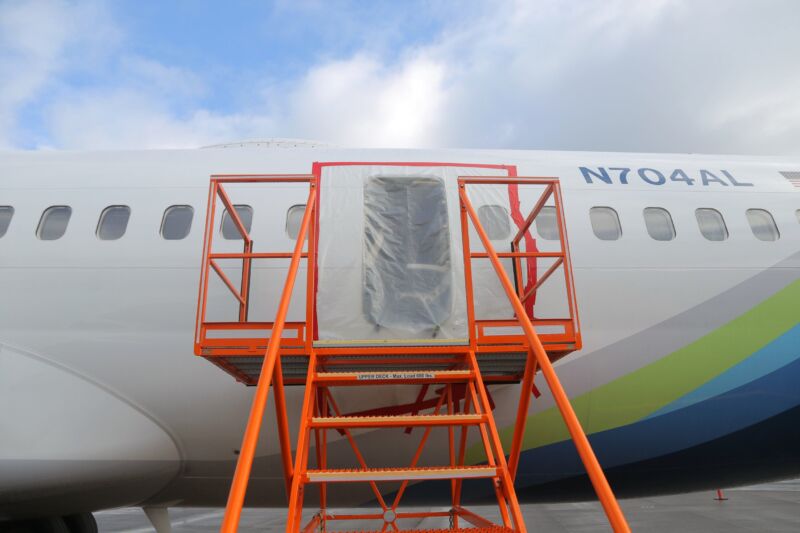Missing bolts —
Boeing workers apparently failed to replace bolts after reinstalling door plug.

Enlarge / A hole is covered where a door plug blew off a Boeing 737 Max 9 plane used by Alaska Airlines.
Getty Images
Boeing is withdrawing an application for a safety exemption related to its 737 Max 7 aircraft as more details emerge on the cause of a near-disaster involving a 737 Max 9 plane used by Alaska Airlines.
While initial inspections of Alaska Airlines’ fleet of Boeing 737 Max 9s turned up “many” loose bolts, a Wall Street Journal report yesterday said it now appears that “bolts needed to secure part of an Alaska Airlines jet that blew off in midair appear to have been missing when the plane left Boeing’s factory.”
“Boeing and other industry officials increasingly believe the plane maker’s employees failed to put back the bolts when they reinstalled a 737 Max 9 [door plug] after opening or removing it during production, according to people familiar with the matter,” the article said.
In the incident on January 5, a Boeing 737 Max 9 lost a passenger door plug while in flight, causing decompression of the passenger cabin and forcing an emergency landing (a door plug is used instead of an emergency exit door in some planes). The Federal Aviation Administration subsequently grounded 171 Boeing planes and informed Boeing that the agency “will not grant any production expansion of the Max, including the 737-9 Max.”
737 Max 7 application withdrawn
With the 737 Max 9 investigation continuing, Boeing confirmed this week that it withdrew an application for a safety exemption for the 737 Max 7. Boeing was facing pressure from US Sen. Tammy Duckworth (D-Ill.), who chairs a subcommittee on aviation safety and operations. Duckworth last week urged the FAA to reject Boeing’s request for “an exemption from safety standards to prematurely allow the 737 Max 7 to enter commercial service.”
“The exemption Boeing seeks involves an anti-ice system that can overheat and cause the engine nacelle to break apart and fall off,” Duckworth wrote. “This could generate fuselage-penetrating debris, which could endanger passengers in window seats behind the wing and/or result in a loss of control of the aircraft.”
Even though a permanent fix is not expected until 2026, Boeing “is asking the FAA to allow the Max 7 to fly with merely a warning to flight crews to remember to manually turn off the anti-ice system when the aircraft emerges from icy conditions,” Duckworth wrote. “This is a request for the FAA to certify a commercial aircraft with a single point of failure subject to human error with potentially catastrophic consequences.”
In a statement provided to Ars and other media outlets, Boeing said it is withdrawing the request for an exemption. “We have informed the FAA that we are withdrawing our request for a time-limited exemption relating to the engine inlet deicing system on the 737-7,” Boeing said. “While we are confident that the proposed time-limited exemption for that system follows established FAA processes to ensure safe operation, we will instead incorporate an engineering solution that will be completed during the certification process.
“As always, the FAA will determine the timing of certification and we will follow their lead every step of the way,” Boeing added. “We’re committed to being transparent, listening to all our stakeholders and taking action to strengthen safety and quality at Boeing.”
Duckworth also met Thursday with Boeing CEO Dave Calhoun. “After this bold-face attempt to put profits over the safety of the flying public with the Max 7 and this month’s horrific Alaska Airlines incident aboard the Max 9, I am as committed as ever to doing everything I can to ensure Boeing aircraft meet all safety standards—and I made that clear in today’s meeting,” Duckworth said.
Details suggest missing bolts on Max 9
The Wall Street Journal report about the Max 9 investigation said that an “apparent absence of markings” on the door plug is one factor suggesting that bolts were missing when the plane left Boeing’s factory. The WSJ said its sources “also pointed to paperwork and process lapses at Boeing’s Renton, Wash., factory.”
“The National Transportation Safety Board has been conducting metallurgical analysis of the [door plug] but hasn’t released the results of the testing. Laboratory tests might show whether the bolts were in place or not there at all,” the article said.
When contacted by Ars today, the NTSB said the agency’s preliminary report is slated to be released on Wednesday and “will include all of the factual information that we have developed at this point in the investigation.” (Update at 3: 38pm ET: The NTSB now says the report will not be issued on Wednesday, and a new date for its release has not been set.)
Boeing said it was unable to comment on the probe because “only the US National Transportation Safety Board can release information about the investigation.”